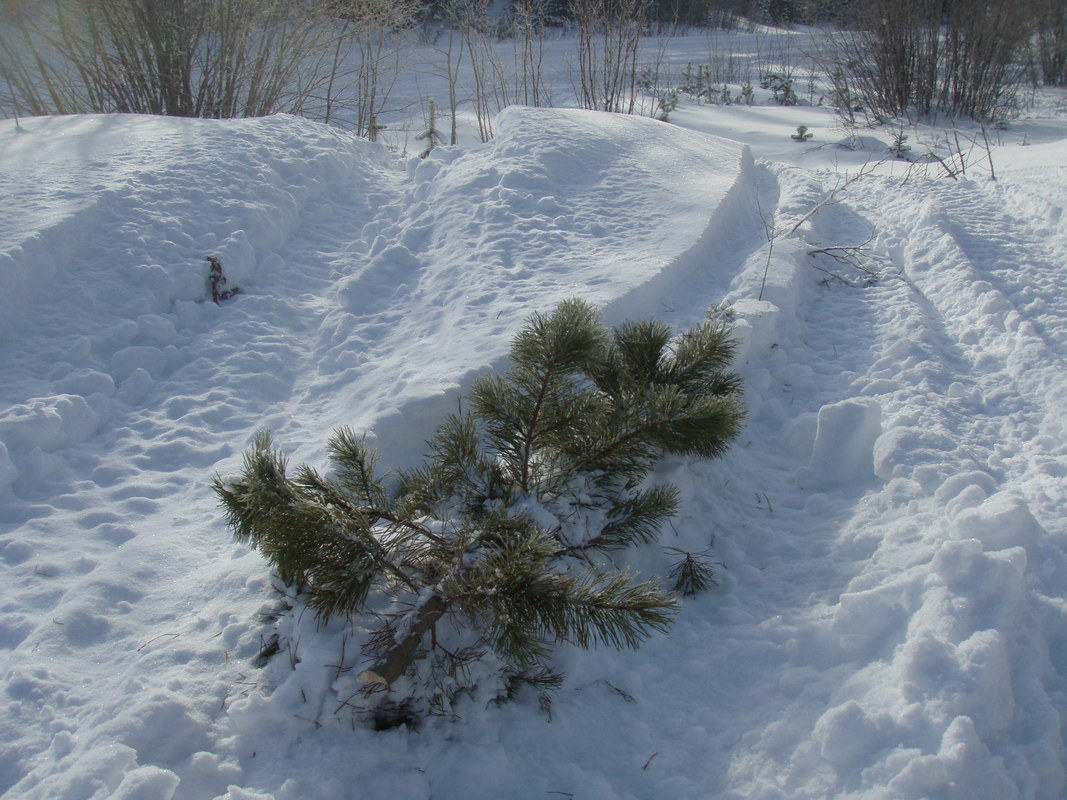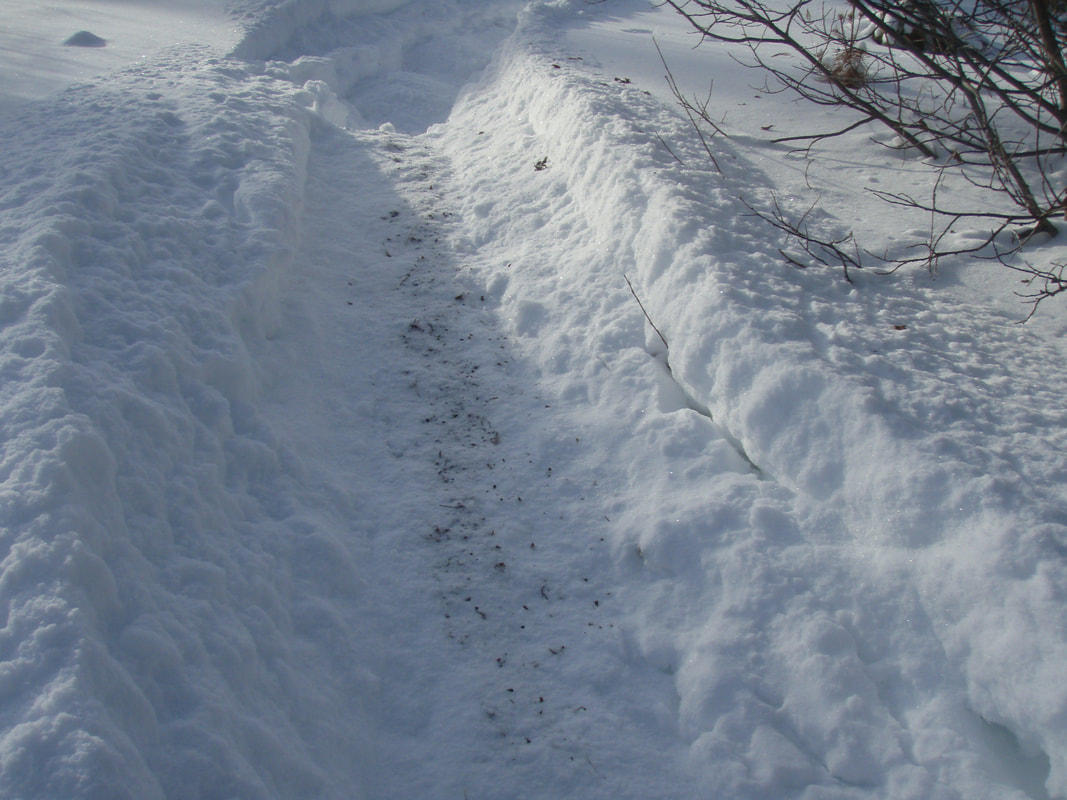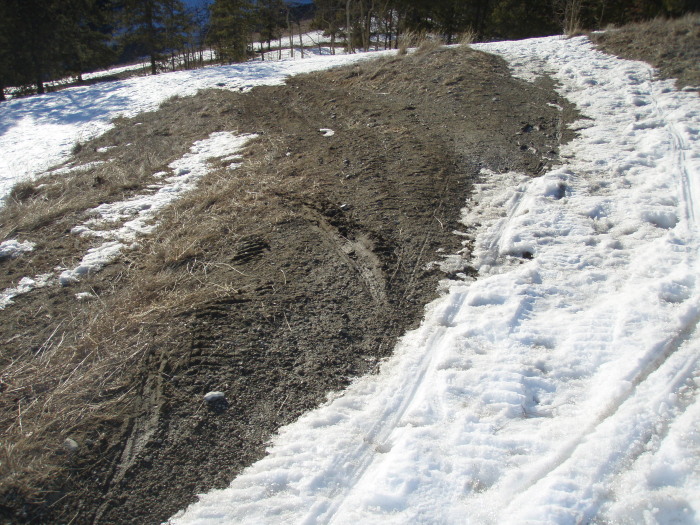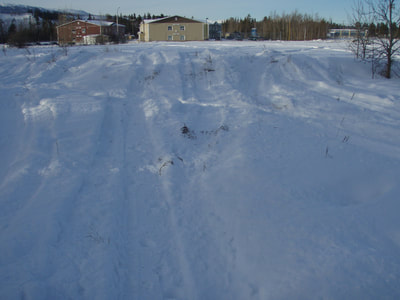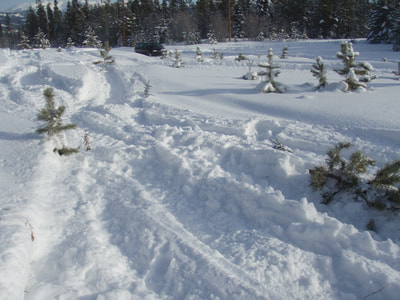Snowmobile impacts on the environment and residents' quality of life:
Snowmobiles are known to cause a number of environmental impacts when driven off-trail: vegetation damage due to snow compaction; destruction of sub-nivean habitat; and stress to wildlife. Generally, the Whitehorse area does not get enough snow depth to prevent vegetation damage from snow compaction. In addition, vegetation that protrudes above the snow isn't always flexible enough to withstand being driven over without damage (bark stripped, branches snapped).
Below are just a couple of the many studies about snowmobile impacts.
Snowmobiles are known to cause a number of environmental impacts when driven off-trail: vegetation damage due to snow compaction; destruction of sub-nivean habitat; and stress to wildlife. Generally, the Whitehorse area does not get enough snow depth to prevent vegetation damage from snow compaction. In addition, vegetation that protrudes above the snow isn't always flexible enough to withstand being driven over without damage (bark stripped, branches snapped).
Below are just a couple of the many studies about snowmobile impacts.
|
| ||||||||||||
_________________________________________________________________________________________________________
|
Yukon government brochure summarizing snowmobile impacts in the Yukon (click the link below or icon on the right):
http://www.env.gov.yk.ca/environment-you/documents/SnowmobilesandtheYukonEnvironment.pdf |
| ||||||
__________________________________________________________________________________________________________
Popular Mechanics has an excellent article on low-impact snowmobiling, recommending that snowmobilers:
“Stay on the trail. Designated snowmobiling trails are meant to protect vulnerable ground. Stay on marked trails and never take your snowmobile across wetlands, along shorelines, or into streams or riverbeds—these areas are especially sensitive to disruption. If you want to explore these places, park beside the trail and walk in (if it is legal to do so).”
See the full article at the following link:
https://www.popularmechanics.com/adventure/outdoors/a10039/the-secrets-of-low-impact-snowmobiling-16443445/
_______________________________________________________________________________________
The Klondike Snowmobile Association (KSA) homepage ( https://ksa.yk.ca/ ) indicates that it is aware of snowmobile impacts.
We feel that snowmobile clubs should promote clear environmental protection guidelines, and clearly state that snowmobiles should stay on designated snowmobile trails. In our city that would mean staying on designed and designated motorized multiple use trails (MMU). These are open to both motorized and non-motorized users. (ATVs in summer and snowmobiles in winter.)
We also feel that responsible snowmobile clubs should recognize a community’s need for quiet non-motorized trails and greenbelts in their neighborhood.
As of August, 2021 there were 605 snowmobile operators in Whitehorse who had taken the required online course to obtain the City's Safe Snowmobile Card and, as a result, are permitted use of City's trails. See https://www.whitehorse.ca/departments/bylaw-services/snowmobiles. We thank those operators.
____________________________________________________________________________________________
Popular Mechanics has an excellent article on low-impact snowmobiling, recommending that snowmobilers:
“Stay on the trail. Designated snowmobiling trails are meant to protect vulnerable ground. Stay on marked trails and never take your snowmobile across wetlands, along shorelines, or into streams or riverbeds—these areas are especially sensitive to disruption. If you want to explore these places, park beside the trail and walk in (if it is legal to do so).”
See the full article at the following link:
https://www.popularmechanics.com/adventure/outdoors/a10039/the-secrets-of-low-impact-snowmobiling-16443445/
_______________________________________________________________________________________
The Klondike Snowmobile Association (KSA) homepage ( https://ksa.yk.ca/ ) indicates that it is aware of snowmobile impacts.
We feel that snowmobile clubs should promote clear environmental protection guidelines, and clearly state that snowmobiles should stay on designated snowmobile trails. In our city that would mean staying on designed and designated motorized multiple use trails (MMU). These are open to both motorized and non-motorized users. (ATVs in summer and snowmobiles in winter.)
We also feel that responsible snowmobile clubs should recognize a community’s need for quiet non-motorized trails and greenbelts in their neighborhood.
As of August, 2021 there were 605 snowmobile operators in Whitehorse who had taken the required online course to obtain the City's Safe Snowmobile Card and, as a result, are permitted use of City's trails. See https://www.whitehorse.ca/departments/bylaw-services/snowmobiles. We thank those operators.
____________________________________________________________________________________________
Some photos from the Whitehorse area...
|
Above: snowmobiling off-trail... and breaking trees.
|
Snowmobiles are powerful. Their tracks can dig through deep snow and can rip out soil and vegetation when used off-trail, as seen in the sprayed debris in the above photo. Most of the damage is still covered by snow, and will only become visible in the spring.
|
|
Snowmobilers should avoid prohibited environmentally sensitive areas (ESAs), where their machines can
damage fragile vegetation, as shown in the photo to the left taken in the Hidden Lakes area near Riverdale. Snowmobiling in ESAs and other areas that lack snow cover causes damage to the root zone, creates rutting, and increases erosion. These effects degrade trails and greenbelts and impact all users. |
Driving snowmobiles in greenbelts can have negative impacts on nearby residents: noise, exhaust fumes, safety hazards, damage to vegetation, and an aesthetically unpleasant rutted landscape.
_________________________________________________________________________________________
Quotes from various Whitehorse surveys and plans:
- 2010 Riverdale Neighbourhood Plan: Section 1.5.3, Questionnaire outcome (page 9)
“Motorized recreational vehicles (ATVs, snowmobiles) were identified as a major point of contention in the community. Many feel disturbed by motorized activity and identify it as a safety issue, particularly in regards to children. The consensus seems to be that laws regarding these vehicles are not being respected and must be more stringently enforced.”
“Furthermore, trails need to be strongly designated as motorized or non-motorized. Many also expressed concern regarding the erosion of trails, and general environmental damage caused by these vehicles.”
- 2010 Whitehorse Official Community Plan section 18.5.1:
“Where feasible, consideration shall be made to separate multi-use trails (which accommodate motorized and non-motorized recreation) from non-motorized trails. Future multi-use trail development shall avoid environmentally sensitive areas wherever possible.”
- 2011 Whitehorse Snowmobile Survey (statistically valid) results:
https://www.activetwa.org/uploads/2/2/7/6/22767404/110701_snowmobile_bylaw_report_july_2011.pdf
“It is important to separate motorized and non-motorized trail use: 59% agree 23% disagree”
(This survey was part of the 2011-2012 public consultation process for the new Snowmobile Bylaw.)
- 2014 Hillcrest Neighbourhood Plan - section 3.4.4.3:
“The City should continue to explore methods such as improved signage, barriers (Figure 11), and compliance monitoring, to ensure All Terrain Vehicles (ATVs) and snowmobiles are used only on trails where motorized vehicles are permitted.”
- 2015-2050 Whitehorse Sustainability Plan:
“Manage greenspace to rehabilitate, limit access, and limit fragmentation” (page 20)
- 2015 ORV impacts and management measures - Survey conducted by Yukon conservation Society, Friends of McIntyre Creek, Porter Creek Community Association
Respondents made numerous comments on the need to keep motorized vehicles off non-motorized trails summer and winter.
- 2016 Whistle Bend, Porter Creek, Takhini survey:
May 2017 “Porter Creek/Whistle Bend/Takhini/Range Point Trail Plan Report:
http://whitehorse.ca/Home/ShowDocument?id=8364 (report is on pages 17 to 24 of agenda package)
Quoting from page 5 of report:
“Survey respondents were also asked to weigh in on the matter of the designation of the paved perimeter trail in Whistle Bend. Options provided (and responses) were as follows:
• Non-motorized year-round (54% agree, 23% oppose, 23% neutral)
• Motorized winter only (34% agree, 40% oppose, 24% neutral)
• Motorized year-round (24% agree, 48% oppose, 27% neutral)”
